- Prelude
- Editorial
- Raghu Rai: The Historian
- Ryan Lobo, 34 in Baghdad
- Through the Eye of a Lensman
- Adrian Fisk
- And Quiet Flows the River
- The Lady in the Rough Crowd: Archiving India with Homai Vyarawalla
- Raja Deen Dayal:: Glimpses into his Life and Work
- Raja Deen Dayal (1844-1905) Background
- Vintage Views of India by Bourne & Shepherd
- The Outsiders
- Kenduli Baul Mela, 2008
- Collecting Photography in an International Context
- Critical Perspectives on Photograph(y)
- The Alkazi Collection of Photography: Archiving and Exhibiting Visual Histories
- Looking Back at Tasveer's Fifth Season
- Kodachrome: A Photography Icon
- Three Dreams or Three Nations? 150 Years of Photography in India, Pakistan and Bangladesh
- Show And Tell – Exploring Contemporary Photographic Practice through PIX
- Vintage Cameras
- Photo Synthesis
- The Right Way to Invest
- What Happened and What's Forthcoming
- Art Events Kolkata: March – April 2011
- Art Bengaluru
- Mumbai Art Sighting
- North East Opsis
- Previews
- In the News
- Somnath Hore
ART news & views
Show And Tell – Exploring Contemporary Photographic Practice through PIX
Volume: 3 Issue No: 16 Month: 5 Year: 2011
by Akshay Mahajan
This is an exceptional time for photography in India. The 'scene' has been instigated by reasons from within and outside the profession, from shifts in the perception of photography, to its reception in the afterlife, i.e. public viewing and critical appreciation. In the 1990s, the art world was slow to embrace photography as a practice that would receive consistent patronage, thereby forcing many practitioners to move away from the art gallery or book format - to find refreshingly alternative, 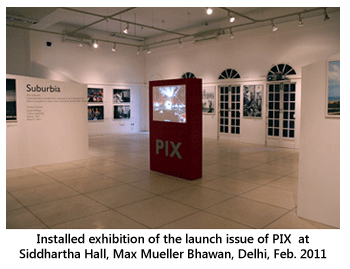 exciting and more artistically disruptive spaces of connecting with their viewership – on the internet, the streets, as well as through innovative, small format publications that sought to showcase an enlarging mass of anonymous practitioners. We know that throughout the history of photography there have always been patrons and supporters of the medium – as a document, an evidentiary tool and vehicle of ideas, but never before have we seen such a large scale interaction, with the underpinnings of being a global media tool.
exciting and more artistically disruptive spaces of connecting with their viewership – on the internet, the streets, as well as through innovative, small format publications that sought to showcase an enlarging mass of anonymous practitioners. We know that throughout the history of photography there have always been patrons and supporters of the medium – as a document, an evidentiary tool and vehicle of ideas, but never before have we seen such a large scale interaction, with the underpinnings of being a global media tool.
In this digital age in India we are witnessing how photographers are devising new strategies for reportage and display practices. Live performances and public events are open to all shutters, and there are far more workshops for the camera and its million wielders than before. Consequently, young photographers seek to share and consume new work that challenges a traditional stereotype of photography: the idea of a 'lone' photographer, a scavenger of daily events, looking for the 'moment' in a picture that has great visual charge and immediate mass appeal. Therefore, photography is slowly moving from the realm of isolated practitioners,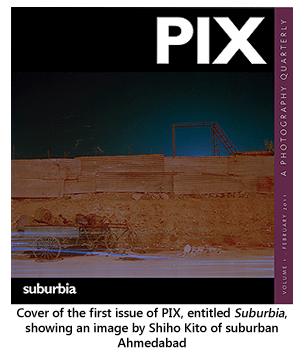 solitary in their practice, to a new age of vibrancy and commitment – almost on the verge of evolving into a conscious 'movement'…but not yet.
solitary in their practice, to a new age of vibrancy and commitment – almost on the verge of evolving into a conscious 'movement'…but not yet.
In this age of new media and virtual interactivity, a new crop of subjects and artists with their own readings, modes of engagement and surfeit of results have emerged, who are eager to dislodge older forms of communication and reception with something viable and 'user-friendly'. There started the idea of PIX, A Photography Quarterly, with a varied team (mentioned hereafter), that hopes to invoke a dialogue on the current of state of Indian photography's ontology, highlighting a compendium of contemporary practices, as seen through the works of emerging image-makers in India and outside an attempt to mine the edifice and artifice of the photograph. Supported primarily by the Goethe Institut/Max Mueller Bhavan (MMB hereafter) in Delhi, it was launched in February 2011 with an exhibition at the Delhi branch of the MMB.
PIX is dedicated to covering visual concepts in a thematic form. The Quarterly is therefore intended as a platform for critiquing, investigating and presenting artists and writers without prior histories of exhibition or publishing, and thereby attempting to explore contemporary aesthetic ideas from across India. Each issue investigates a timely theme in photography and the related arts. The first issue was titled Suburbia.
Artists such as Shiho Kito present nightscapes from Ahmedabad(Gujarat) evoking an intimate yet detached series of sharp large format images. 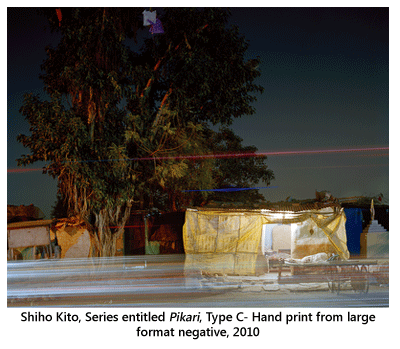 Often, the works of photographers are juxtaposed with writers of history, poetry and fiction. On the other hand, when presented as an exhibition, the monumental scale and breathtaking visual clarity, allowed for an in-depth search into the 'making' of an image, not only the act and intention of shooting it. Shiho, in her own text, further superimposes a depersonalised vision of new suburban towns in Japan. While spending time at NID in Ahmedabad, she realised that at night, the lights of the smaller settlements around reminded her of her hometown. This also suggests the coming of change in urban India, not only in its cities but also at a suburban level. The work of 10 other photographers filled the pages of PIX, from Manu Thomas' images of grimy subways near Haji Ali, Mumbai to Ronny Sen's pictures of the breathlessness of passengers and migrants inside the unreserved compartment on Indian railway trains.
Often, the works of photographers are juxtaposed with writers of history, poetry and fiction. On the other hand, when presented as an exhibition, the monumental scale and breathtaking visual clarity, allowed for an in-depth search into the 'making' of an image, not only the act and intention of shooting it. Shiho, in her own text, further superimposes a depersonalised vision of new suburban towns in Japan. While spending time at NID in Ahmedabad, she realised that at night, the lights of the smaller settlements around reminded her of her hometown. This also suggests the coming of change in urban India, not only in its cities but also at a suburban level. The work of 10 other photographers filled the pages of PIX, from Manu Thomas' images of grimy subways near Haji Ali, Mumbai to Ronny Sen's pictures of the breathlessness of passengers and migrants inside the unreserved compartment on Indian railway trains.
Following preliminary discussions about the quarterly's incentive, the following note was conceived as an editorial ethics of engagement. It sheds light on the manner in which the contemporary can be approached:
'The structure of the Quarterly was consciously based on practices, technologies, forms of curating and the circulations of photography in India today. Photography has come to be viewed as a means of the everyday, in possessing the power to influence us and even lead us astray. Images are now animated beings,  with desires of their own and have started being cast into contemporary notions of picture theory associated with the visual arts, literature and mass media. This quarterly therefore is about opening new vistas in iconology and the emergent field of visual culture. For example, the 'city' as geographic and abstract space plays an important role by being the subject of reportage or the motivation behind commissioned work. The city is itself a living being, and a gallery space. How do photographers use it?
with desires of their own and have started being cast into contemporary notions of picture theory associated with the visual arts, literature and mass media. This quarterly therefore is about opening new vistas in iconology and the emergent field of visual culture. For example, the 'city' as geographic and abstract space plays an important role by being the subject of reportage or the motivation behind commissioned work. The city is itself a living being, and a gallery space. How do photographers use it?
Alternately, how/why do photographers seek their subjects? What are their inclinations and is it dependent on a vast consumption of images for mass media? The use of various format cameras such as the mobile phone camera are also being utilised for alternative reasons, personal and political. How does this alter the realness of representation? How have exhibitions in the last 10 years altered ways of viewing the domain of photography? Do young photographers provide an alternative to the mainstream? Who are these photographers?'
In the end, what has the digital indeed proved? To begin with, digital photography allowed many young Indian photographers to create volumes of archives quickly taken, quickly edited, tagged, named, captioned and with a click a mouse, shared on the internet with millions across the world. This potentially more fluid interaction is allowing viewers and photographers alike 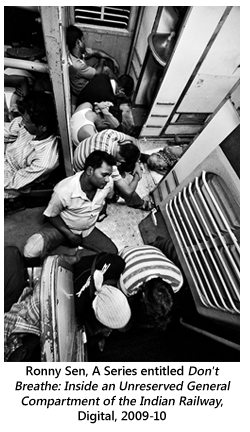 to experience an open-ended initial encounter – a sense of the present that is temporal yet important to retain as part of a compendium of our daily lives. The end transformation that happened on Internet's "photo-sharing" platforms such as flickr was almost encyclopedic in terms of possibilities for Indian visual telling.
to experience an open-ended initial encounter – a sense of the present that is temporal yet important to retain as part of a compendium of our daily lives. The end transformation that happened on Internet's "photo-sharing" platforms such as flickr was almost encyclopedic in terms of possibilities for Indian visual telling.
What we saw was a more playful space, having more to do with a conversation through images. I remember seeing a photograph on the Internet of a young Indian bride on her honeymoon in Paris, as she relished a packet of Haldirams 'masala dal' (The picture was titled- Meri Bibi Eating Haldirams in Paris). The internet and the digital medium allowed for 'Indian' photography to start resembling an oral tradition where diverse views of a new visual language were being written and were on full view as long as it illustrated the written keywords. Though this is not ideal for photography, which has its own modes of engagement, it creates an immediate viewership that begins to understand that images are in fact coded in more subtle ways than one imagines.
Therefore, this wave of Indian photographers has slowly started shifting opportunities from the Internet into the brick and mortar world. Websites such as Blindboys.org, which first started as online galleries showcasing new Asian perspectives, tried to reach out to photographers and audiences by taking photography to the street, a practice that has always been viewed as avant-garde in some sense. Using the Internet and social media and then translating them in real events like Blow-Up - an improvised street exhibition where everyone is invited to display their work on the street together with other photographers.
This new landscape of the consumption and practice of contemporary photography is further enriched by other recent publications like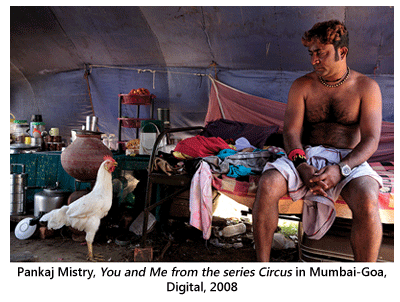 Punctum that showcases photography from a Pan-Asiatic point of view as well as Camerawork Delhi, a free quarterly newsletter in print with a focus on photography in Delhi. Due to all these efforts that supplement initiatives like PIX, a community of like-minded photographers has started to take root, including people with the firm belief that opportunities to show and share should be available to everyone - a gigantic leap from earlier ways of circulating photography.
Punctum that showcases photography from a Pan-Asiatic point of view as well as Camerawork Delhi, a free quarterly newsletter in print with a focus on photography in Delhi. Due to all these efforts that supplement initiatives like PIX, a community of like-minded photographers has started to take root, including people with the firm belief that opportunities to show and share should be available to everyone - a gigantic leap from earlier ways of circulating photography.
Postscript
Look out for the next issue of PIX, entitled Outsider, due to be released on 27 May 2011 at the MMB Delhi.
PIX Quarterly is available in limited numbers at the MMB in Delhi, as well as other branches in India. Theme for the third issue of PIX is: 'Imagineries: Exploring Photo Art'. Last date for submission: 1July 2011.
Images Courtesy: PIX